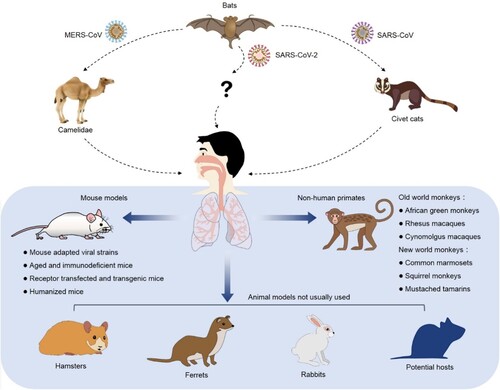Figures & data
Figure 1. Experimental animals of SARS-CoV, MERS-CoV and SARS-CoV-2. The coronaviruses with high infectivity and pathogenicity break the species barrier and infect human in the past two decades. Besides NHP, mice, hamsters, ferrets and rabbits, the other possible natural hosts might be able to support the studies of coronavirus infection, pathogenesis and drug discovery.

Table 1. Natural infectious animal model for SARS-CoV and MERS-CoV.
Table 2. Representative receptor transgenic and transfected mice support SARS-CoV and MERS-CoV infection.
Figure 2. Mutations in MA stains of SARS-CoV and MERS-CoV. (A) Nucleic acid and amino acid mutations of SARSMA strain MA15, MA20, and v2163 [Citation39]. (B) Amino acid changes of MERS-CoV S1 (receptor binding) and S2 (fusion) domains of different plaques and clones of the EMC-P30 strain [Citation36].
![Figure 2. Mutations in MA stains of SARS-CoV and MERS-CoV. (A) Nucleic acid and amino acid mutations of SARSMA strain MA15, MA20, and v2163 [Citation39]. (B) Amino acid changes of MERS-CoV S1 (receptor binding) and S2 (fusion) domains of different plaques and clones of the EMC-P30 strain [Citation36].](/cms/asset/955de995-ac47-4e3b-a11a-b127815ffebe/temi_a_1764871_f0002_oc.jpg)
